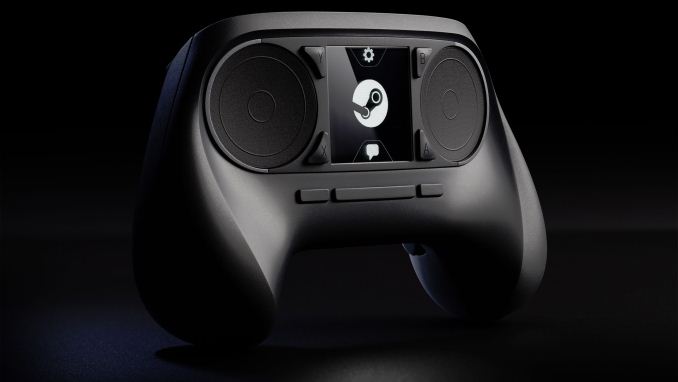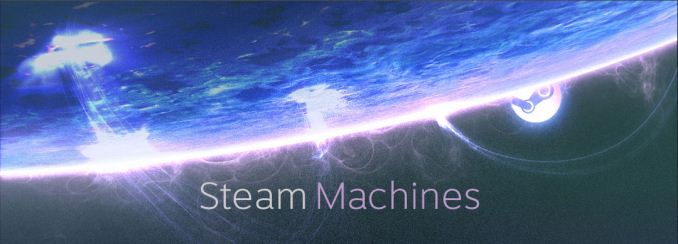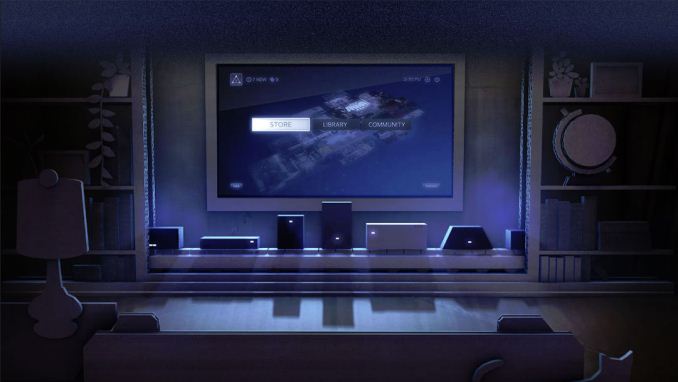Analyzing Valve’s SteamOS, Steam Machines, and Steam Controller Announcements
by Jarred Walton on September 28, 2013 3:00 AM EST- Posted in
- Gaming
- Linux
- Valve
- Steam
- SteamOS
- Steam Controller
- Steam Machines

In 2012, Valve released an update to their Steam platform called Big Picture, which essentially consisted of a new user interface tailored towards the needs of the living room where people use large HDTVs and gamepads in place of the usual keyboard and mouse interface. We’ve seen 10-foot UIs before – Windows Media Center and most of the game console interfaces being prime examples – and they’re pretty much required if you want a UI people can use while sitting on the couch. Along with Big Picture, the past several years have also seen Valve and Steam branch out from being a Windows-only software solution to something that’s available on OS X, Linux, and even (in a more limited fashion) on the PlayStation 3. Not every game within Steam is currently available on every platform, but increasingly we’re seeing more titles launch with support for all of the supported Steam platforms.
With all of the pieces in place, we started hearing rumblings about the “SteamBox” earlier this year, with most people assuming that Valve would put together something akin to a gaming console with a predefined set of hardware. This week, Valve has released additional details about what they’re planning, and it’s a move that will definitely shake up the gaming industry. Valve is taking a three-pronged approach, and they released some information about each aspect over the course of the past week: SteamOS, Steam Machines, and the Steam Controller. Many details are not yet finalized, but let’s quickly go over what we do know.
The Triple Header
Perhaps the most interesting aspect of the announcement is that Valve will be releasing a new operating system, SteamOS. Similar to Google’s Android and Chrome OS, SteamOS will be based on Linux, and obviously there will be a lot of tuning to make SteamOS work well as a living room OS. Valve specifically mentions support for in-home streaming; music, TV, and movie services; and family options to allow the sharing of games between Steam profiles.
Valve is also promising the ability to play all of the current ~3000 titles available on Steam, but unfortunatley it appears Windows/OS X titles will only be available via streaming (e.g. similar to NVIDIA's SHIELD streaming games from your PC to your SHIELD device). It would be nice to see Valve do something similar to WINE (Wine Is Not Emulator) for those titles that don’t have native Linux support, but that's perhaps more of a long-term solution. Needless to say, it comes as no surprise that recently both NVIDIA and AMD made note of the fact that they will be doing additional work to improve Linux driver support moving forward.
Other aspects of SteamOS basically build off of everything that makes Steam as a platform so attractive to many users. All of your games that you purchased – any time in the history of Steam – are available anywhere you log in. Your friends list comes with you, save games and settings are stored in the cloud, and the Steam Workshop provides a wealth of user created content. Steam is currently available in 185 countries and 25 languages, and as anyone that has used Steam since it first debuted a decade ago can attest, Valve is constantly looking on ways to improve the platform. SteamOS may be the next evolution of Steam as a platform, but of course Valve will continue to support other operating systems as well.
The second bullet point is perhaps the easiest to understand: the Steam Machines are preconfigured hardware solutions from various partners that will run SteamOS. We don’t know precisely what the hardware will be, but all signs point to it being mostly off-the-shelf hardware that you could use in building any modern PC. There will likely be entry-level hardware, midrange hardware, and high-end solutions that cover a range of price points and performance.
Valve will be releasing a prototype Steam Machine to 300 beta testers over the coming months, selected more or less randomly from applications received before October 25. We’ll know more about the precise hardware configuration Valve is using in a month or so. It will also be possible to download and install SteamOS on your own (though we're not sure when SteamOS will go public), so at its most basic level a Steam Machine is just any PC that happens to be running SteamOS.
The third and final item that Valve announced is their new Steam Controller. Gamepads are nothing new for gaming consoles, but the Steam Machines are in a somewhat unique position of providing a vast library of games where many titles were not built with gamepads in mind, and certainly not the Steam Controller (which hasn't existed prior to this announcement).

The Steam Controller is significantly different than what we’ve seen with most gamepads. Instead of the usual dual thumbsticks, the Steam Controller includes two high-resolution circular trackpads, which are also clickable. In addition, there will be 16 buttons (with the ability to shift between left or right hand configurations via a software switch) and a touchscreen in the center – though the initial prototype will have four buttons in place of the touchscreen. Valve is also promising improved haptics (i.e. force feedback) via dual linear resonant actuators (small, strong, weighted electromagnets attached to the circular trackpads).
As with SteamOS, Valve is promising full compatibility with the entire Steam library, which means they need a way for their gamepad to work in place of the keyboard and mouse that some titles are going to expect. The combination of a touchscreen, various buttons, and the circular touchpads together provide the necessary platform, and a utility will allow users to customize any game for the new controller. Valve will also be leveraging the power of their Steam Community to allow users to share custom configurations, so similar to NVIDIA's GeForce Experience and AMD's new Gaming Evolved (powered by Raptr), you won't necessarily need to roll your own for each game you play.
Tying It All Together
So that’s the short overview, and as usual the proof is in the eating of the pudding – a pudding that we don’t have yet. Given that digital entertainment is a rapidly growing market, it’s easy to understand why Valve would be interested in moving beyond Steam in its current form to something that can compete with game consoles (and perhaps even Android and iOS at some point, though Valve makes no mention of such a use case right now). SteamOS will be available for free, both to end users and manufacturers, but it’s interesting that there’s no mention of it being open source – the core OS will continue to be open, naturally, but I suspect all of the custom code that speaks to Valve’s servers will never see the light of day (which is fine by me).
A more cynical perspective might say that there’s nothing particularly new or shocking in this announcement. Sure, we’re getting a new gamepad at some point, and another Linux-based operating system, but if you already have a Windows PC connected to your HDTV and running Steam, this hasn’t really changed the equation much. And depending on how many games need to be streamed from a Windows/OS X system to your Steam Machine, it's even less of a big deal.
Still, Microsoft is going to get even more competition from alternative OSes, and as someone that enjoys competition I’m not going to complain. It also means that Valve has the potential to increase their revenue stream, not so much from the hardware side but rather there’s the potential for inexpensive Steam Machines to take over the roles that are currently filled by traditional consoles, and of course every game purchased on a Steam Machine is going to come through Steam. You can almost hear the “ka-ching”!
There’s a difference between Steam Machines and traditional consoles of course – or at least there appears to be. There’s no specific set of hardware being dictated by Valve, which means for better or worse users will still have to deal with customizing graphics settings, resolutions, etc. and developers still need to worry about catering to a wide range of hardware with sometimes radically different levels of performance. On the bright side, it also means that Steam Machines won’t have to last 7 to 10 years between updates.
What I’m most interested in seeing right now is what sort of performance we actually get out of SteamOS, on a variety of hardware, with native SteamOS (Linux) games. We all know that Windows is a tremendously bloated operating system – just look at the default install size of Windows 7 or Windows 8. However, just because there’s a bunch of extra stuff that we may not use all that much doesn’t mean that Windows as a gaming platform isn’t viable. I haven’t personally done any testing of gaming performance on Windows versus gaming performance on OS X or Linux, but anecdotally Windows performance has been substantially better in nearly every case.
Valve has the potential to change the equation; with an OS focused much more on gaming, performance in SteamOS could be competitive or even better than what we see under Windows. Of course, for non-Linux titles that are streamed from your Windows/Mac system, performace will be no better and you'll incur a small penalty in latency. Even if SteamOS were to get something similar to WINE, we’re talking about adding additional overhead to DirectX/OpenGL, at least initially. It’s a pretty big stretch to expect better performance from SteamOS when it initially launches in 2014, but down the road we might see some real changes in the status quo. Give NVIDIA and AMD some time to work with Valve, and maybe we’ll see porting of AMD’s Mantle to the platform as well (and NVIDIA’s CUDA, etc.).
Short-term, we have more questions than answers, but this is definitely a bold (if somewhat expected) move from Valve. They’ve gone from creating games to becoming perhaps the largest “game publisher” around, and their next step appears to directly challenge behemoths like Microsoft (on both the Windows and Xbox fronts), Sony, and Nintendo. I’d be lying if I didn’t admit that I would really like to see Valve succeed at altering the gaming system landscape yet again. How long might it take to get that? Probably more than a year or two, best-case.
As noted above, Valve will be sending out 300 prototype Steam Machines, mostly to randomly selected applicants. You can read details on how to apply for the beta program on the Steam Machines page, which would get you not only the prototype Steam Machine but also the prototype Steam Controller. You need to apply before October 25, and participants will apparently be selected and receive their prototype machines before the end of 2013. (Wish me luck!)
Source: Valve/Steam



















77 Comments
View All Comments
Death666Angel - Saturday, September 28, 2013 - link
The ~50 to 150€ you have to spend on a Windows licence comes to mind as a thing in favor of SteamOS, no? :)iniudan - Saturday, September 28, 2013 - link
Yes, has Steam Machine, will have SteamOS on them, so you have no Windows license coming with them.But the nice thing about Steam Machine, is that it is also hardware that you know will have Linux driver, so I do see people wanting an OEM build Linux desktop, simply getting one, then installing their favorite distro on it.
Gmanyy - Saturday, September 28, 2013 - link
So I get better hardware for the same price. That's a plus.It also provides more incentive for the devs to port to Linux their future titles, because in addition to some hypothetical Linux geeks there will be some normal people using SteamOS.
But Windows allows me to do so much more even from the gaming perspective: not only steam has much more windows-compatible games, but Windows can support additional distribution platforms, which are guaranteed to be locked out of the SteamOS (my speculation).
What if I'm perfectly fine with paying $150 for Windows license? (And in fact, if you get it preinstalled, you pay much less, because OEMs have bulk deals.)
quagga - Saturday, September 28, 2013 - link
The platform is open; I don't see any reason why EA couldn't bring Origin to it. I don't know that I'd see them bringing Origin to it, but I think they could.I believe I paid 109 for the Windows 8 license on this gaming machine I have. I consider it a waste of money since the OS is garbage and it's just a loader for Steam but I also considered it the price of admittance. But if I didn't have to pay that, I wouldn't. You like Windows so you see no advantage to an alternative platform; I abhor Windows so wouldn't even have it installed if I didn't need it for Steam. It's a waste of hard drive space. Different things for different folks.
I really think what SteamOS is, is a bargaining chip. I see SteamMachines eventually being sold with Windows for all of the reasons you state. However having SteamOS gives Valve or their OEM partners leverage for a better deal on those bulk Windows licenses. Then they'll have the base model running SteamOS and the Windows model for $100 more.
Gmanyy - Saturday, September 28, 2013 - link
I see your point. Of course not everybody wants/needs the whole package that Windows is. And it makes sense not to install identical systems (and thus pay excessive price) on the hardware with different purposes.Thanks!
MrSpadge - Saturday, September 28, 2013 - link
Except that you need that Windows licence anyway. Sure, there will be a few more games with native linux support comming. But if you "want to play xyz now" instead of asking "OK guys, I'm bored.. what do you have in store?" you'll probably be disappointed by the answer for a long time.tuxRoller - Sunday, September 29, 2013 - link
You're forgetting about wine. It isn't unusual to see windows apps running faster under wine. Game support isn't bad as long as the title doesn't require more than d3d 9c (as I understand it that includes even new titles).JarredWalton - Sunday, September 29, 2013 - link
Most games that aren't console ports are now using at least DX10, and frequently DX11. While DX9 is still available in the vast majority of games, on newer titles it will mean giving up image quality and potentially performance.tuxRoller - Sunday, September 29, 2013 - link
I thought I had indicated as much, but, as you've stated, so much the clearer now.Additionally, there is this (http://www.phoronix.com/scan.php?page=news_item&am... project. However, since that makes use of the gallium interface it will only be used by the oss drivers (but the radeon drivers are now pretty damn close to fglrx for gaming benchmarks with dvfs now enabled).
All of this aside, the porting becomes a much smaller issue if games are written with a cross-platform graphics engine such as unity.
Kevin G - Saturday, September 28, 2013 - link
Windows over the years has gotten incredibly bloated. The only two advantages is the selection of games and the optimizations on the driver level. Steam for OS X/Linux have changed the game selection dynamic a bit while AMD/nVidia/Intel have all been putting more effort into driver optimizations on other platforms. I see SteamOS + AMD's Mantle has a great opportunity to increase performance and/or image quality for gaming.